Article Information
- Hu Zhang, JianMing Zhang, ZhiLong Zhang, MingTang Chai . 2017.
- Deformation behavior of in situ permafrost on the Qinghai-Tibetan Plateau
- Sciences in Cold and Arid Regions, 9(2): 112-119
- http://dx.doi.org/10.3724/SP.J.1226.2017.00112
Article History
- Received: November 21, 2016
- Accepted: January 20, 2017
Thaw settlement of permafrost can exert an unfavorable effect on engineering constructions such as embankments, transmission towers, piles, petroleum pipelines, and housing buildings in permafrost regions of the Qinghai-Tibetan Plateau (Jin et al., 2005; Wang et al., 2006; Qi et al., 2012; Wu and Niu, 2013; Wang et al., 2014; Guo and Sun, 2015; Zhang, 2016). Likewise, these constructions can seriously disturb the underlying permafrost, warming the ground soil and rapidly increasing settlement (Cheng, 2003; Chen et al., 2006; Guo et al., 2009; Zhang, 2016). So, to ensure the safe operation of infrastructure, more and more cooling measures have been proposed and carried out to keep the subgrades frozen. Even though a frozen state is maintained, the creep of permafrost is still considerable (Zhang et al., 2007; Zheng et al., 2010) and can cause many problems for constructions, like differential settlement, wave pavement, and pavement fractures. Therefore, focusing on the creep behavior of permafrost is of great importance to help explain the engineering problems and predict long-term deformation.
Many researchers have made great efforts in studying the creep behaviors of frozen soils and have achieved much (Tsytovich, 1985; Andesland and Ladanyi, 2004; Vyalov, 2005). However, most of these results were obtained in the laboratory. The indoor creep experiments on remolded soil samples can give good results under controlled conditions but cannot reflect the natural behaviors of in situ permafrost. Consequently, field tests are required to access the exact creep properties of in situ permafrost (Sayles, 1988).
Field tests are a way to obtain the most credible mechanical parameters and deformation behavior of soil (Shen, 1996). Among the tests available, the plate loading test is a convenient method for observing the bearing capacity and creep behavior of in situ frozen ground. It causes little disturbance to soil status and reflects the influences of soil structure and temperature variation on the mechanical behavior. Starting in 1952, Vyalov (1978) conducted some plate loading tests that lasted nearly 20 years at the Igarka permafrost station in Russia. In the tests, the settlements were observed developing at steadily decreasing rates under the condition of relatively steady ground temperatures. To measure the in situ long-term creep rate of the permafrost foundation, Lunne and Eidsmoed (1988) carried out plate loading tests for a year in Saea on Svalbard, where the ground temperature was much lower. On the Qinghai-Tibetan Plateau, Zhu et al. (1983) carried out in situ plate loading tests on ice-rich frozen ground for a few months and suggested that the settlements (volumetric ice content 80% to 90%) always appeared a progressive style once stress exceeded 0.07 MPa and temperature rose above −0.4 °C. However, data are still scare on the long-term creep behavior of in situ permafrost, especially the warm permafrost of the Qinghai-Tibetan Plateau.
In this study, we carried out plate loading tests on the Qinghai-Tibetan Plateau for many years and investigated the variation of ground temperature and deformation of the platforms. Then, the influences of ground temperature and volumetric ice content on settlement and frost heave were analyzed.
2 Experimental site and equipment 2.1 Test equipmentTo investigate the creep behavior of in situ permafrost, three plate loading systems were installed in 2009 (referred to as PL09-1, PL09-2, PL09-3, respectively). Each system contained two components, a platform and the loading piles (Figure 1). The platform was an equilateral triangle with a side length of 3 m (Figure 1), and three steel-pipe piles were used to support the platform. At the bottom of each pile, a circular steel plate with a diameter of 30 cm was welded as a loading part buried just below the permafrost table, as shown in Figure 2. The piles were installed in a 320-mm-diameter hole, which was auger-drilled in the dry to the desired depth. After pile placement was finished, the annulus between the pile and the hole-wall was backfilled with fine sand. The piles were vibrated during the backfilling to densify the sand. Each of the piles was lubricated with grease and encased with a plastic pipe to prevent potential uplift due to frost heave.

|
| Figure 1 Plate loading system |
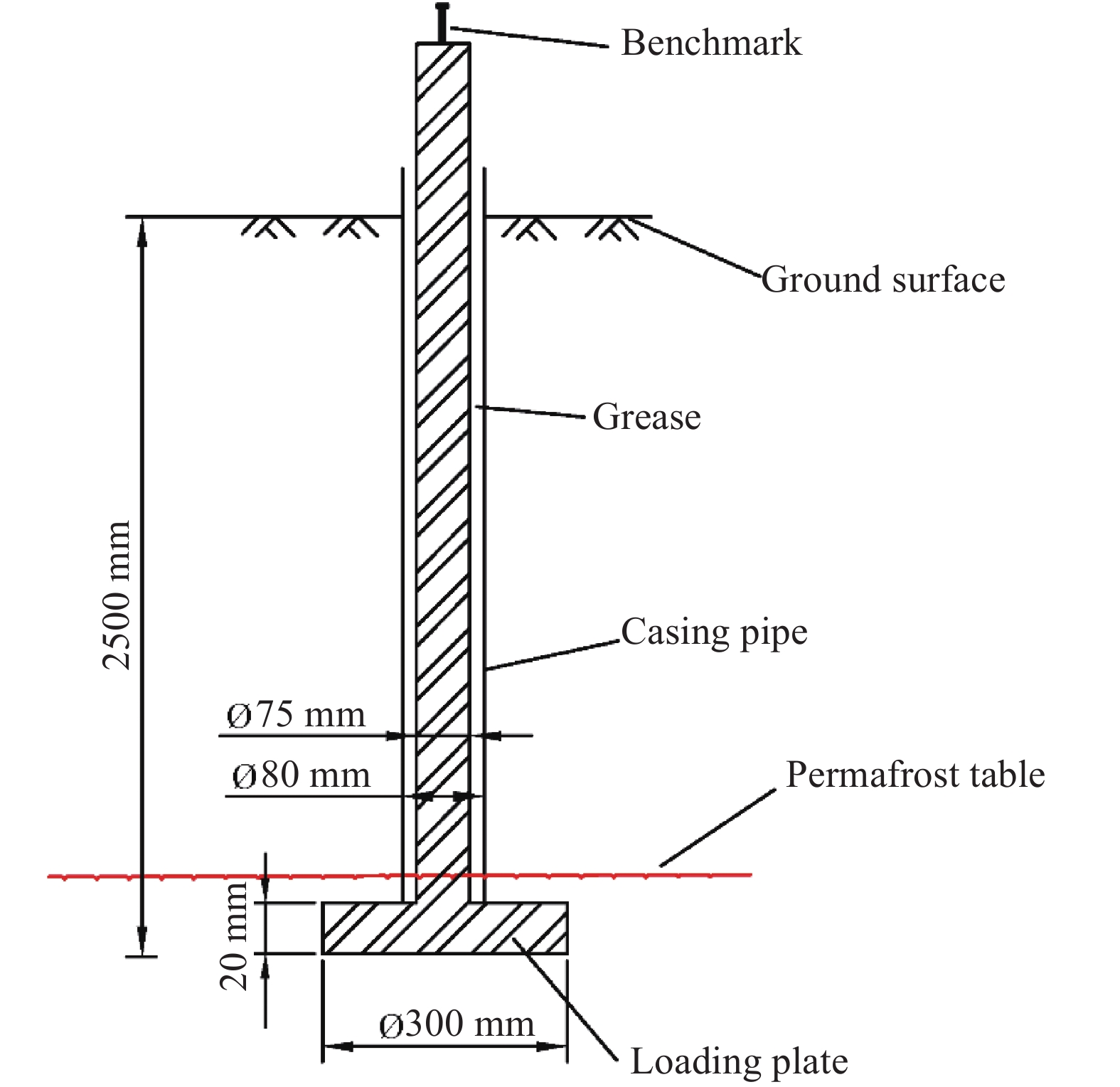
|
| Figure 2 Vertical profile of the loading pile |
Under the center of each platform, 31 thermistors were installed at intervals of 0.5 m in a 15-m-deep borehole to measure ground temperature variation at different depths. These thermistors, with a precision of ±0.05 °C and a sensitivity of ±0.01 °C, were made by the State Key Laboratory of Frozen Soil Engineering (SKLEFS). During the process of drilling, soil types and volumetric ice contents were recorded in detail. The piles were an end-bearing style, therefore the pile group effect can be ignored when analyzing the test results.
2.2 Experimental siteThe creep experiments were carried out at Beiluhe Basin on the Qinghai-Tibetan Plateau (latitude 34°49′15.2″N, longitude 92°55′39.5″E, altitude 4,618 m), as shown inFigure 1. The ground surface of this site is flat, with sparse vegetation.
The mean annual air temperature is −3.8 °C, with an extreme high temperature of 23.2 °C and an extreme low temperature of −37.7 °C. The mean lowest temperature of the ground surface (at the depth of 5 cm) is −8 °C, while the mean highest temperature is 6 °C. The permafrost table is about 2~3 m deep. Beneath the permafrost table are usually found ice-rich frozen soils, which are mostly composed of silty clay, according to the drilling data ( Figure 4). Generally, the mean annual ground temperature (MAGT) varies between −0.4 and −1.8 °C ( Niu et al., 2002).

|
| Figure 3 Test site location (The area is relatively flat and covered with low grass; the vegetation rate is about 70%~80%. The view is panoramic, and there is a small pool nearby) |
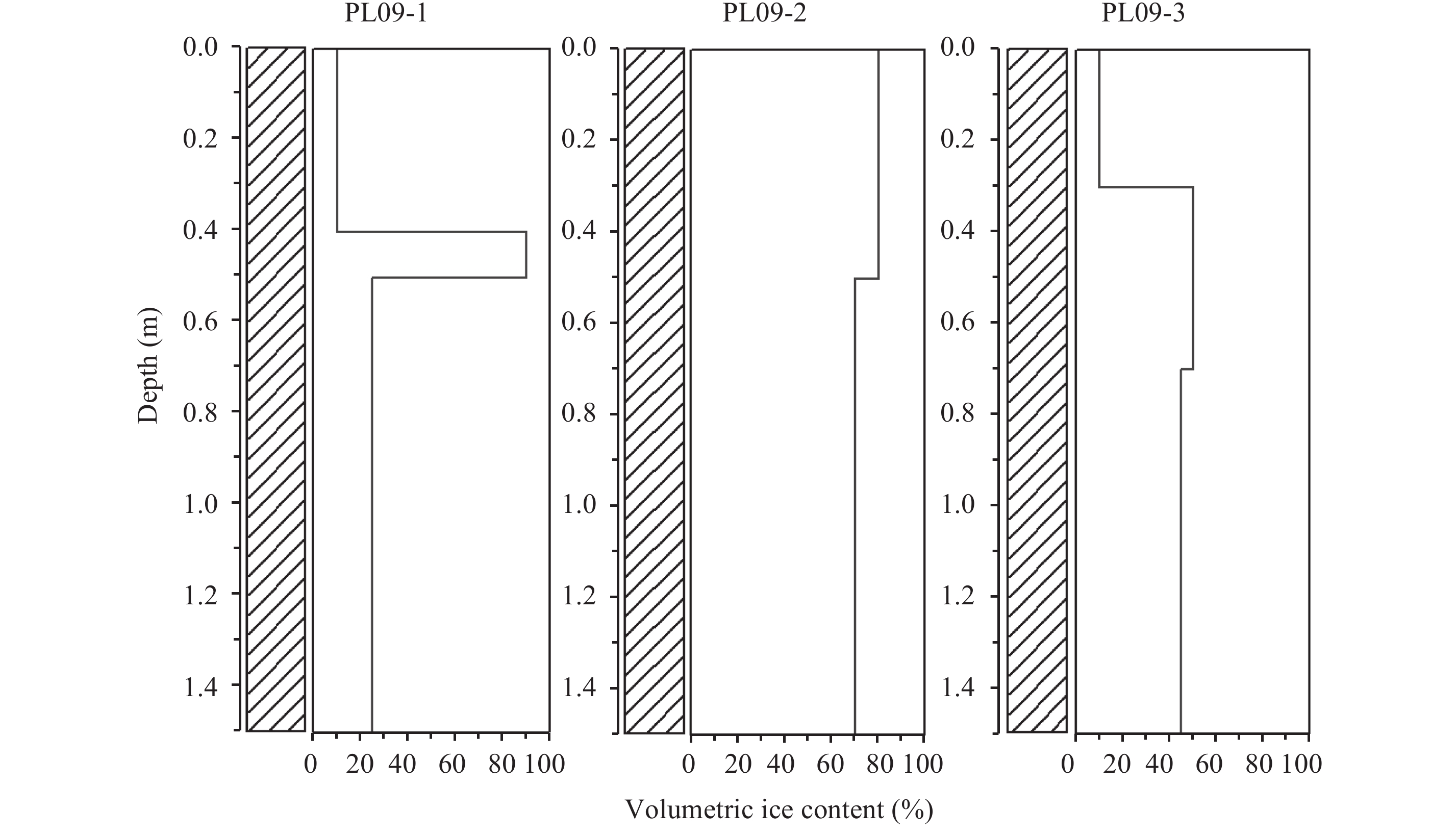
|
| Figure 4 Geological profile beneath the loading plates (The shadow area means silty clay) |
After the equipment was installed, ground temperatures were measured at regular intervals. When the ground temperatures reached a natural level, an additional load was quickly put on the platforms, using concrete blocks that were distributed to avoid a shift in the center of gravity. On September 10, 2010, PL09 was loaded: 0.25 MPa. The deformations were measured manually with a high-precision electronic level, which was operated twice a month by well-trained technicians.
3 Results 3.1 Ground temperature variationFigure 5 shows the ground temperatures under the PL09 platforms at different depths. The ground temperatures appeared to be normal at the beginning of the measurement, illustrating a slight disturbance to the ground temperature from the hole-drilling.

|
| Figure 5 Ground temperature variations (at the depths of the loading plate and 15 m) |
The permafrost table was at a depth of about 2.0 m. At the depth of the loading plates, the ground temperatures represented a seasonal fluctuation, alternately slowly warming and rapidly cooling. PL09-1 had a greater amplitude of ground temperature variation than the others. The average upper and lower limits of the ground temperature were −0.57 °C and −1.42 °C for PL09-1, −0.40 °C and −2.42 °C for PL09-2, and −0.29 °C and −3.03 °C for PL09-3. Moreover, during each seasonal period, it took most of the time (about 9 months) for the permafrost to warm up.
The mean annual ground temperatures for PF09 were between −1.1 °C and −1.2 °C. However, they were not constant but increased year by year with the linear rates of 0.024 °C/a, 0.018 °C/a, and 0.015 °C/a, respectively. This finding confirms the degradation process of the permafrost, and the degradation rate is consistent with the data proposed by Jin et al. (2011).
3.2 Deformation variationAs illustrated in Figure 6, PL09 produced considerable settlements in about 6 years: 107, 255, and 72 mm, respectively. Large differences in creep curves between them were displayed. When loads were applied, simultaneous settlements occurred; however, the values could essentially be ignored, compared with subsequent creep deformation. Instead of developing at a constant deformation rate, the creep curves presented a seasonal variation. This occurrence was caused by the fluctuation of the ground temperature.
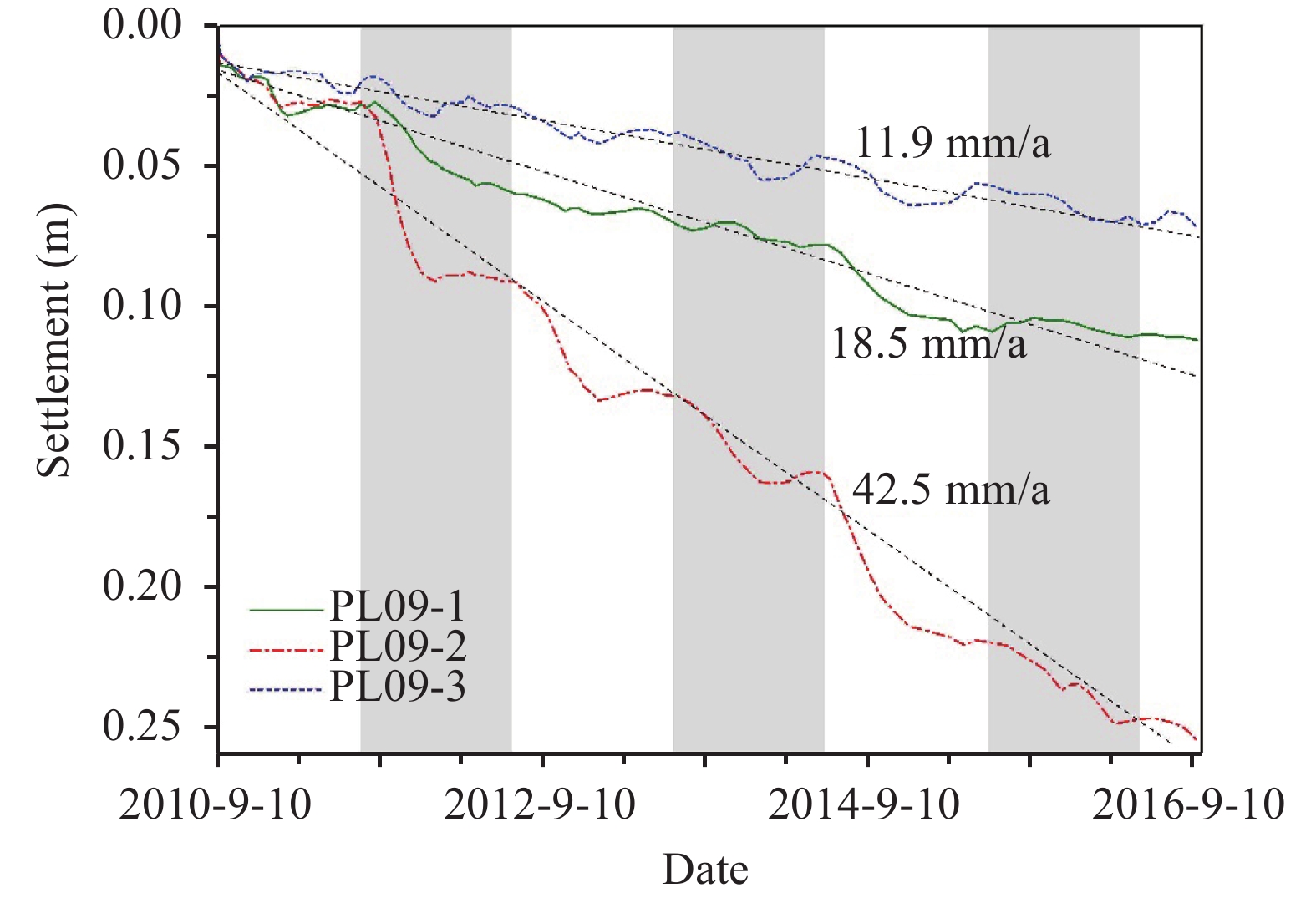
|
| Figure 6 Creep curves |
Although the permafrost beneath the loading plate did not experience freeze–thaw cycles, a slight frost heave still took place in it. As shown inFigure 6, the evident uplift phenomenon appeared on the three deformation curves, with that of PL09-3 the most prominent. Overall, the deformations of PL09 were characterized by settlement. However, when the frost heave was great, the development of total settlement was hindered, as with PL09-3.
The creep curves were indicative of increasing settlements without an attenuating pattern. Generally, they developed in fluctuation with a certain slope: 18.5, 42.5, and 11.9 mm/a, respectively.
4 Discussion 4.1 Deformation characteristicIn referring to ground temperature, one finds that the development trend of deformation has a direct relationship with the ground temperature (Figure 7). A remarkable increase in settlement occurred as the ground temperature became warmer. With the decrease of the ground temperature, the plate showed a tiny settlement rate or even a small frost heave. But deformation did not begin to accelerate until the ground temperature warmed to a certain point. For example, this temperature point for PL09-2 was about 1.0 °C. Actually, the point varied with the soil type and ice content.
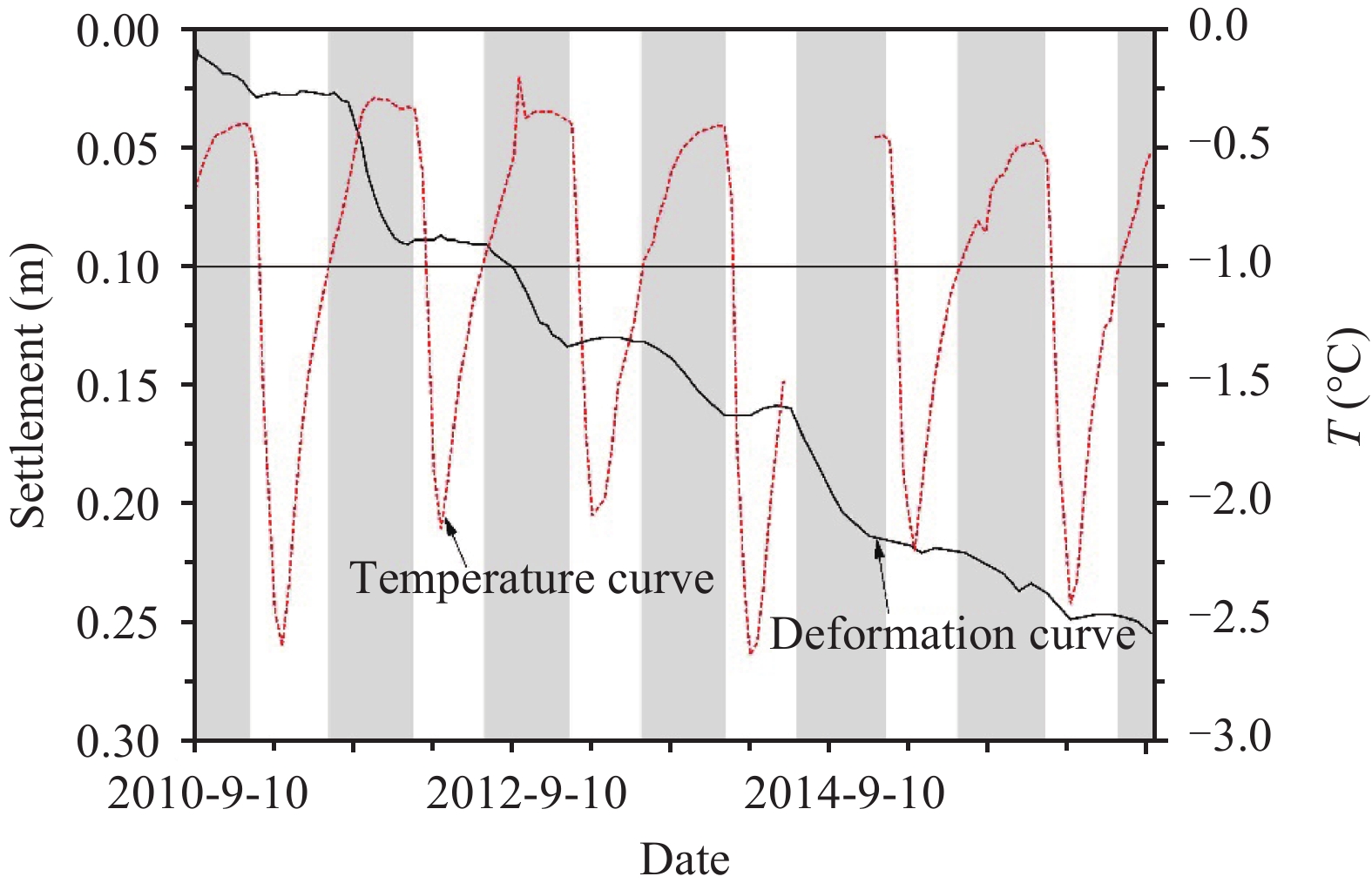
|
| Figure 7 Comparison of deformation curve with ground temperature curve (PL09-2) |
In the deformation development of permafrost, frost heave makes the deformation process more complex. Although frost heave is much smaller, it still offsets the total settlement to some extent. The loading plate is located below the permafrost table, so the frost heave may be caused by the freezing of in situ unfrozen water and the migrating water from thawed upper soils.
Frost heave promotes occurrence of two forms of deformation curves, step form (Figure 8a) and wave form (Figure 8b). The step form appears in two situations. One is when the frost heave does not take place or is very slight, as with PL09-1; the other is when the settlement developed in the warm seasons is very large in relation to frost heave produced in the cold seasons, so the frost heave can probably be ignored, as with PL09-2. Once the frost heave is relatively considerable, compared with the settlement, an evident uplift trend on the deformation curve appears to give rise to a wave-form deformation.
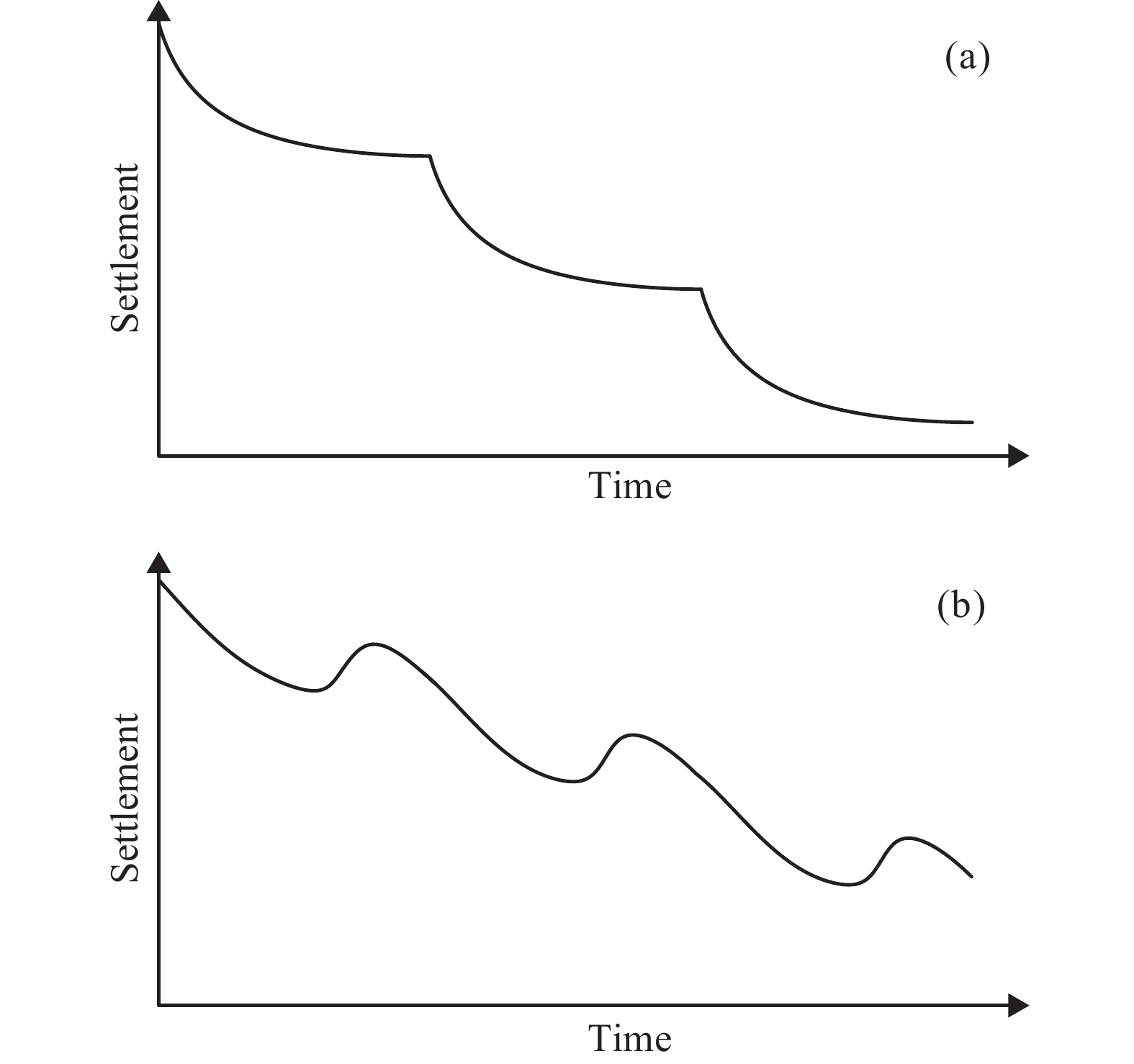
|
| Figure 8 Two forms of creep curves. (a) step form; (b) wave form |
As mentioned, the creep magnitudes and curve styles of the permafrost are different at different locations, which should be attributed to the influence of ground temperature and moisture content, given similar soil types (Arenson and Springman, 2005; Ma et al., 2008).
According to elastic theory, the additional stress at 0.5 m below the loading plate is only about one-tenth of the external load. The permafrost within the upper 0.5 m below the loading plate can be regarded as a compressive layer.
In view of similar mean upper-limit ground temperatures, the differences in mean settlement in warm seasons among the platforms are mainly attributed to the differences in volumetric ice content in the compressive layer (Figure 9). Under PL09-2, the volumetric ice content is very high and the settlement in warm seasons is much greater than those for the others. For PL09-1 and PL09-3, similar volumetric ice contents give rise to closely similarly settlements in warm seasons. However, PL09-3 has the greatest frost heave in cold seasons, which may be caused by the freezing of the in situ unfrozen water within 30~50 cm beneath the loading plate, occurring under conditions of high volumetric ice content and substantial cooling. The small frost heave for PL09-1 may be caused by the higher temperature in cold seasons. And the negligible frost heave for PL09-2 may be a result of the interaction of frost heaving and settlement still developing in cold seasons. In general, on the premise that warm ground temperature inevitably occurs, moisture content may be a more important factor than ground temperature in weakening the engineering properties of permafrost.
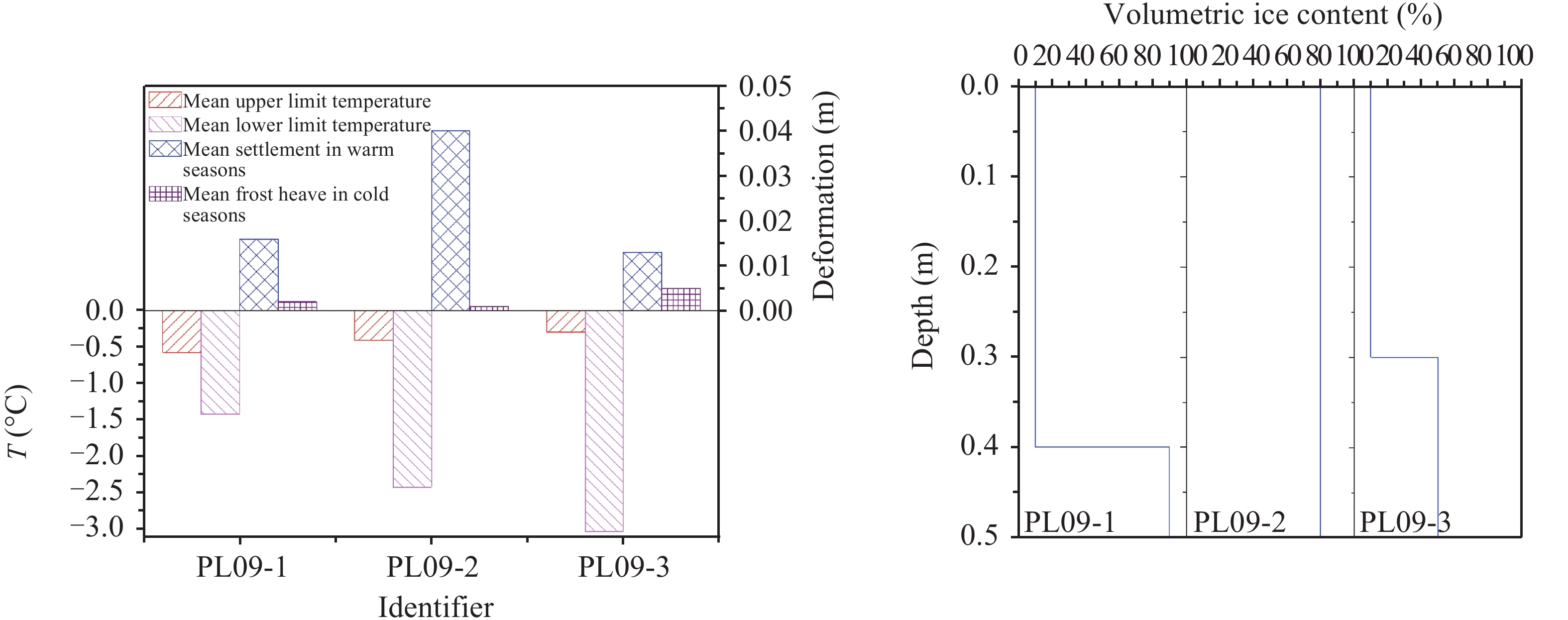
|
| Figure 9 Relationship between deformation and influencing factors |
At temperatures below 0 °C, most of the water becomes ice. Then, frozen soil was commonly regarded as a solid material; and the deformation under an external load was merely considered as creep by researchers ( Arenson and Springman, 2005; Arenson et al., 2007; Qin et al., 2009). However, a considerable amount of unfrozen water still exists in frozen soil, particularly at the subzero temperatures near 0 °C ( Anderson and Morgenstern, 1973; Qin and Zhang, 2010), as shown in Figure 10. Once an additional load was applied, the squeezing of pores in frozen soil causes the increase in pore-water pressure. Moreover, it has been demonstrated by several investigators (Burt and Williams, 1976; Andersland et al., 1996; Watanabe and Osada, 2016; Zhang et al., 2016) that the hydraulic conductivity for water in frozen soils is small but not zero, and that Darcy's law is applicable to a frozen soil with pore-ice if the ice pressure gradient is negligible. If drainage is allowed, excess pore-water pressure dissipates and the original stress state reestablishes. This sequence results in a change in volume of the soil matrix (Vyalov, 1978; Tsytovich, 1985; Andesland and Ladanyi, 2004; Arenson et al., 2007). This conclusion implies that frozen soil undergoes consolidation, which eventually leads to transfer of applied stresses to the grain structure. Sayles (1988) also indicated that the consolidation of frozen soils could account for more than one-third of the total soil deformation at temperatures near the freezing point. In addition, with the warming of the ground temperature, a part of the ice thaws into unfrozen water, which not only results in a shrinkage of the soil but also promotes the development of the consolidation.
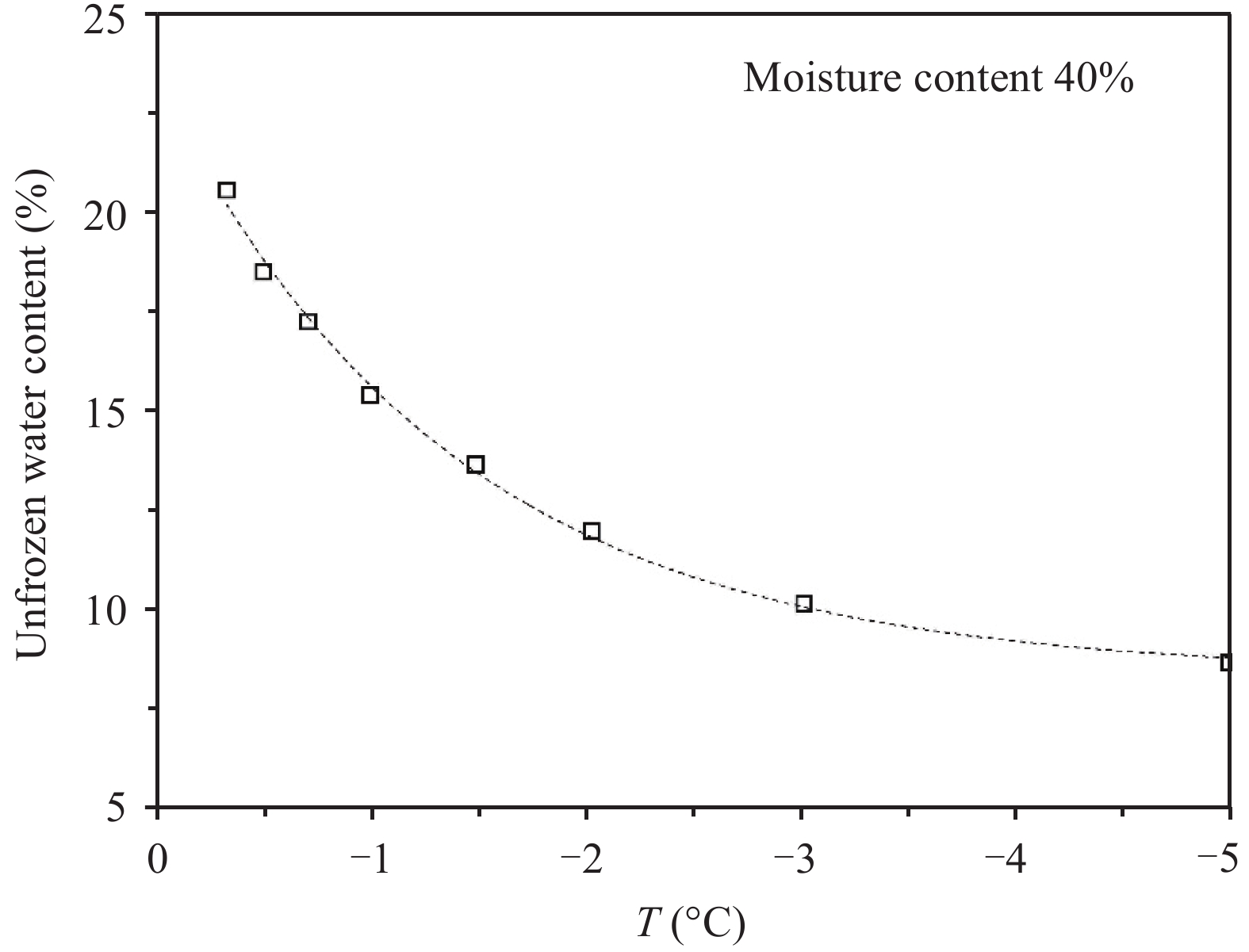
|
| Figure 10 Relationship between unfrozen water content and temperature (Ma et al., 2007) |
For the permafrost in the compressive layer in the plate loading tests, the ground temperatures are considerably higher in warm seasons, thus a significant amount of unfrozen water exists. The consolidation of permafrost resulting from migration of unfrozen water along seepage channels may play a significant role in the total deformation, especially for the ice-rich permafrost like PL09-2, in addition to the movement of soil particles and the flow of ice.
5 ConclusionTo access the natural creep properties of in situ permafrost, we carried out a group of plate loading tests on the Qinghai-Tibetan Plateau. The main conclusions are as follows:
1) The ground temperatures of in situ permafrost represented a seasonal fluctuation. The temperature at the loading plates ranged from −0.29 °C to −3.03 °C, and the mean annual ground temperature increased year by year in linear fashion.
2) Affected by the ground temperature variations, two forms of deformation curves, step-form and wave-form, occurred. This phenomenon was induced by the relative extent of settlement in warm seasons and frost heave in cold seasons. Generally, the deformations were still characterized by settlement. But there was a large variation in deformation magnitude and curve style between different locations.
3) Ground temperature and moisture content are two important factors influencing the mechanical behaviors of in situ permafrost, of which the moisture content may be the more important factor—on the basis that warm ground temperature inevitably occurs.
4) In warm seasons, a significant amount of unfrozen water exists in warm permafrost; then the migration of unfrozen water along seepage channels under additional load results in a consolidation action that may play a significant role in the settlement of the permafrost.
Acknowledgments:This project was supported by the National Natural Science Foundation of China (No. 41401087), the Independent Foundation of the State Key Laboratory of Frozen Soil Engineering (No. SKLFSE-ZT-35), and the Foundation for Excellent Youth Scholars of CAREERI, CAS (No. Y551C91001), and the Technology Program of Qinghai Traffic Science Institute (No. Y490E21001).
| Andersland OB, Wiggert DC, Davies SH, 1996. Hydraulic conductivity of frozen granular soils. Journal of Environmental Engineering, 122(3): 212–216. DOI: 10.1061/(ASCE)0733-9372(1996)122:3(212). |
| Anderson DM, Morgenstern NR, 1973. Physics, chemistry, and mechanics of frozen ground: a review. The North American Contribution to the Second International Conference on permafrost, Washington D.C., National Academy of Sciences, pp. 257–288. |
| Andesland OB, Ladanyi B, 2004. Frozen Ground Engineering. Hboken, Ne Jersey, John Wiley & Sons Inc.. |
| Arenson LU, Springman SM, 2005. Mathematical descriptions for the behaviour of ice-rich frozen soils at temperatures close to 0 °C. Canadian Geotechanical Journal, 42: 431–442. DOI: 10.1139/t04-109 |
| Arenson LU, Springman SM, Sego DC, 2007. The rheology of frozen soils. Applied Rheology, 17(1): 12147-1–12147-14. DOI: 10.3933/ApplRheol-17-12147 |
| Burt TP, Williams PJ, 1976. Hydraulic conductivity in frozen soils. Earth Surface Processes,: 349–360. |
| Chen XB, Liu JK, Liu HX, et al., 2006. Soil Freezing and Foundation. Beijing: Science Press. |
| Cheng GD, 2003. Construction of Qinghai-Tibet railway with cooled roadbed. China Railway Science, 24(03): 1–4. DOI: 10.3321/j.issn:1001-4632.2003.03.001 |
| Guo DX, Sun JQ, 2015. Permafrost thaw and associated settlement hazard onset timing over the Qinghai-Tibet engineering corridor. International Journal of Disaster Risk Science, 6(4): 347–358. DOI: 10.1007/s13753-015-0072-3 |
| Guo HX, Wu QB, Zhang LX, 2009. The thermosyphon technology in cold regions: application and research. Journal of Glaciology and Geocryology, 31(6): 1137–1142. |
| Jin HJ, Yu WB, Chen YC, et al, 2005. Frost heave and thaw settlement in the engineering design and construction of oil pipelines in permafrost regions: a review. Journal of Glaciology and Geocryology, 27(3): 454–464. DOI: 10.3969/j.issn.1000-0240.2005.03.021 |
| Jin HJ, Luo DL, Wang SL, et al, 2011. Spatiotemporal variability of permafrost degradation on the Qinghai-Tibet Plateau. Sciences in Cold and Arid Regions, 3(4): 281–305. DOI: 10.3724/SP.J.1226.2011.00281 |
| Lunne T, Eidsmoed T, 1988. Long term plate load tests on marine clay in svea, svalbard. Proceedings of 5th International Conference on Permafrost, Trondheim, Norway, Tapir Publishers, 2: 1282–1287. |
| Ma W, Liu D, Wu QB, 2008. Monitoring and analysis of embankment deformation in permafrost regions of Qinghai-Tibet railway. Rock and Soil Mechanics, 29(3): 571–579. |
| Ma XJ, Zhang JM, Chang XX, et al, 2007. Experimental study on creep of warm and ice-rich frozen soil. Chinese Journal of Geotechnical Engineering, 29(06): 848–852. |
| Niu FJ, Zhang JM, Zhang Z, 2002. Engineering geological characteristics and evaluations of permafrost in beiluhe testing field of Qinghai-Tibetan railway. Journal of Glaciology and Geocryology, 24(3): 264–269. |
| Qi JL, Yao XL, Yu F, et al, 2012. Study on thaw consolidation of permafrost under roadway embankment. Cold Regions Science and Technology, 81: 48–54. DOI: 10.1016/j.coldregions.2012.04.007 |
| Qin YH, Zhang JM, Zheng B, et al, 2009. Experimental study for the compressible behavior of warm and ice-rich frozen soil under the embankment of Qinghai-Tibet Railroad. Cold Regions Science and Technology, 57(2): 148–153. DOI: 10.1016/j.coldregions.2009.02.006 |
| Qin YH, Zhang JM, 2010. Estimating the stability of unprotected embankment in warm and ice-rich permafrost region. Cold Regions Science and Technology, 61(1): 65–71. DOI: 10.1016/j.coldregions.2009.12.001 |
| Sayles FH, 1988. Mechanical properties of frozen soil. Proceedings of 5th international symposium on permafrost engineering, pp. 143–159. |
| Shen ZJ, 1996. Sampling of undisturbed soil samples or in-situ test—an attempting discussion on development direction of soil parameters testing technology . Chinese Journal of Geotechnical Engineering, 18(5): 90–91. |
| Tsytovich HA, 1985. Mechanics of Frozen Soils. Beijing: Science Press. |
| Vyalov SS, 1978. Long-term settlement of foundations on permafrost. Proceedings of third international conference on permafrost. Edmonton. NRC, Ottawa. |
| Wang GS, Yu QH, Guo L, et al, 2014. Prevention and control of freezing ang thawing disasters in electric transmission lines constructed in permafrost regions. Journal of Glaciology and Geocryology, 36(1): 137–143. DOI: 10.7522/j.issn.1000-0240.2014.0017 |
| Watanabe K, Osada Y, 2016. Comparison of hydraulic conductivity in frozen saturated and unfrozen unsaturated soils. Vadose Zone Journal, 15(5): 1539–1663. |
| Wang JZ, Li SS, Zhou GQ, et al, 2006. Analysis of bearing capacity of pile foundation in high temperature permafrost regions with permafrost table descending. Chinese Journal of Rock Mechanics and Engineering, 25(Suppl. 2): 4226–4232. |
| Wu QB, Niu FJ, 2013. Permafrost changes and engineering stability in Qinghai-Xizang Plateau. Chinese Science Bulletin, 58(10): 1079–1094. DOI: 10.1007/s11434-012-5587-z |
| Vyalov CC, 2005. Rheology of Frozen Soil. Translated by Liu JK et al.. China Railway Science, Beijing. |
| Zhang JM, Liu D, Qi JL, 2007. Estimation on the settlement and deformation of embankment along Qinghai-Tibet railway in permafrost regions. China Railway Science, 28(3): 13–17. |
| Zhang H, Zhang JM, Zhang ZL, et al, 2016. Hydraulic conductivity measurement of qingzang silty clay at subfreezing temperatures. Chinese Journal of Geotechnical Engineering, 38(6): 1030–1035. |
| Zhang Y, 2016. Monitoring and analysis of frozen earth temperature and foundation subsidence of low suspended building foundation of Qinghai-Tibet railway. Railway Standard Design, 60(5): 125–129. DOI: 10.13238/j.issn.1004-2954.2016.05.027 |
| Zheng B, Zhang JM, Qin YH, 2010. Investigation for the deformation of embankment underlain by warm and ice-rich permafrost. Cold Regions Science and Technology, 60: 161–168. DOI: 10.1016/j.coldregions.2009.08.012 |
| Zhu YL, Liu YZ, Xie XD, 1983. In-situ creep test research of ground ice on Qinghai-Tibet Plateau. Proceedings of the Permafrost Research on Qinghai-Tibet Plateau, pp. 124–130. |
 2017, 9
2017, 9


